Download Vatios 1.0 Programmer`s Manual
Transcript
Vatios 1.0
Programmer’s Manual
Juan Antonio Victorio Ferrer
University of Zaragoza
Vatios 1.0 Programmer’s Manual
III
Table of contents
Table of contents ...................................................................................................................... III
1. Presentation ........................................................................................................................ 1
2. Simulator Software Architecture........................................................................................ 2
3. Adding another technology point....................................................................................... 4
4. Adding new power models................................................................................................. 5
5. Adding a new unit, with its power model. ......................................................................... 9
5.1.
Declaring the Unit ...................................................................................................... 9
5.2.
Adding auxiliary strings ............................................................................................. 9
5.3.
Counting the number of accesses ............................................................................. 10
5.4.
Creating the power models....................................................................................... 11
5.5.
Adding the call to the function that calculates power/energy .................................. 12
6. Adding the Vatios library to an existing SimpleScalar based simulator.......................... 13
7. Adding Vatios to a non-SimpleScalar based simulator.................................................... 16
Vatios 1.0 Programmer’s Manual
1
1. Presentation
Vatios is a free simulator, written in C that can be used to get power and energy consumption
values from super-scalar processors. It implements the same architecture as Wattch and not
only provides the same functionality, but also gives more flexibility and new interesting
features.
Vatios has been developed trying to allow the advanced-user to modify it with few effort. In
order to do that, it’s recommended to be familiar with the SimpleScalar simulator.
As Vatios and Wattch are based on SimpleScalar, if you have a modified simulator based on
SimpleScalar you can easily add power/energy prediction, only including some headers, their
correspondent files in the directory and some code in your simulator.
Moreover, if you have a simulator that isn’t based on SimpleScalar, you can generate a file
with the same structure and required information as the dump files that sim-vatios
generates and then, you can process it with power-vatios, calculating the predictions.
This manual has been written to help you understanding how Vatios works and will guide you
if you try to modify Vatios. If you are not familiar with the simulator or you haven’t read the
user manual, we strongly recommend doing that first.
Basically, there are 4 ways you would like to modify Vatios.
o Add another technology point.
o Add a new power model for a unit (a new way of calculating the peak power of a unit)
o Add a new unit, with its power model.
o Add the Vatios library to an existing SimpleScalar based simulator.
o Use the Vatios library to calculate power/energy based on the statistics generated by a
non-SimpleScalar based simulator.
2
PFC Vatios – Juan Antonio Victorio Ferrer
2. Simulator Software Architecture
This simulator is based on SimpleScalar, thus it contains the same files as SimpleScalar, but
there are 2 files that have been modified:
- options.c has been slightly modified to allow dump use/access info.
- sim-outorder.c has been renamed to sim-vatios.c and we have added the code to
measure the use of the units and dump that use to a file.
We have replaced the CACTI 1.0 tool with CACTI 4.2, therefore, you will find a directory
called cacti4_2.We use CACTI to calculate subbanking of cache memories and to directly
calculate the power of cache-like arrays.
We have created a new executable power-vatios created from power-vatios.c that
uses files dumped by sim-vatios to calculate power/energy consumption (allowing the
user to modify power models, frequency, technology…)
We have created access_vatios.c and access_vatios.h. In these files we define
the number of units that the processor is made of, and we define functions to count the use of
units. These functions are used by sim-vatios.c
In vatios_strings.h we have written the strings used to refer to the units and used to
display information to the user.
At the file calculatePower.h we have written the code (power models) to calculate the
peak power of a unit, which will be escalated to calculate the actual energy consumption. In
this file we call CACTI when necessary. This file is included in power.c.
In power.c and power.h you will find generic functions to calculate the power of a unit.
You will find the calculate function, which calculates and displays all the energy/power
results and is called by power-vatios and by sim-vatios.
Once you have compiled the simulator, 2 executable files will be generated: sim-vatios
and power-vatios.
Vatios 1.0 Programmer’s Manual
3
This diagram shows the simulator software architecture:
CACTI 4.2
Vatios_strings.h
Calculate Power.h
String definitios for units.
Algorithms that
calculate power.
(Power models)
Access_vatios.c/h
Power.c/h
-Provides functions to calculate
power/energy
-Uses global vars, defined at simvatios or power-vatios
Provides:
Functions to count and dump use/activity in simtestvatios.
Number of units and Identifiers.
Sim-vatios
Power-vatios
-Simulates temporal excution
-Calculates power/energy
-Dumps access/use Statistics & Architecture File
-Reads access/use Statistics & Architecture
File
-Calculates power/energy
Architecture params.
Access/use file
4
PFC Vatios – Juan Antonio Victorio Ferrer
3. Adding another technology point
A technology point is the definition of some parameters determined by your fabrication
process. Vatios comes with some technology point defined, but if you want to make
simulations in a technology point not defined in Vatios, you can add the information needed
to simulate in that point.
Wattch’s author developed some functions to calculate the power of several kinds of
structures (for example RAM, CAM…). These functions use some variables, whose initial
values depend on some parameters: CSCALE, RSCALE, LSCALE, ASCALE, VSCALE,
VTSCALE, SSCALE, GEN_POWER_SCALE, which are factors relative to the 0.80um
fabrication process that represent the wire capacitance, wire resistance, length , area, voltage,
threshold voltage, sense voltage and power.
So, let’s see how we would add a new technology point:
In the file power.c there is a function called:
void init_vatios_tech_params(double techPoint)
At the beginning of this function, there’s a switch clause. You have to add your technology
point there. As an example, you can see how the tech point for 90nm is defined (Numbers are
not real!). The 8 scaling factors you have to define for your tech point are relative to the
800nm fabrication process.
case 180:
CSCALE
=(19.7172)/* wire capacitance scaling factor */;
RSCALE
=(20.0000)/* wire resistance scaling factor */;
LSCALE
=0.2250
/* length (feature) scaling factor */;
ASCALE
=(LSCALE*LSCALE)
/* area scaling factor */;
VSCALE
=0.4
/* voltage scaling factor */;
VTSCALE
=0.5046
/*threshold voltage scaling factor */;
SSCALE
=0.85
/* sense voltage scaling factor */;
GEN_POWER_SCALE = 1;
break;
case 90:
CSCALE
=(35.232)/* wire capacitance scaling factor */;
RSCALE
=(37.5000)/* wire resistance scaling factor */;
Vatios 1.0 Programmer’s Manual
5
LSCALE
=0.1150
/* length (feature) scaling factor */;
ASCALE
=(LSCALE*LSCALE)
/* area scaling factor */;
VSCALE
=0.3
/* voltage scaling factor */;
VTSCALE
=0.5046
/*threshold voltage scaling factor */;
SSCALE
=0.64
/* sense voltage scaling factor */;
GEN_POWER_SCALE = 1;
break;
case 400:
…
…
4. Adding new power models
First of all we want to introduce what a power model is. In Vatios, a power model is simply
an algorithm that calculates a unit’s peak power. For one unit, can be defined several power
models, for example, we can have a cache and two power models, the first one that uses the
functions defined by Wattch, and the second one that uses the latest version of CACTI.
When you are using your simulator, you can select the model for the unit introducing this
parameter in the command line:
-unit_name:model power_model (Example: –dcache:model 3)
You may want to add new power models to improve or to give different choices when
calculating the energy of a unit. The power model calculates the power of the unit and returns
a double value.
First of all, you have to write the C code that calculates the maximum power that this unit can
consume in one cycle. There’s a file in the main program directory whose name is
calculatePower.h. For every unit there’s a switch instruction and at least “case 0:” and
“case 1:” and “case 2”. What you have to do is to add another “case #:”where # is the number
you are going to use for this model.
Let’s see an example:
This would be the code after adding my new model.
6
PFC Vatios – Juan Antonio Victorio Ferrer
switch(energyModels[RENAME]){
case 0: /*Don’t’ count this unit*/
power.powerAFIndependent[RENAME] = 0.0;
break;
case 1:/* Default Wattch model*/
power.powerAFIndependent[RENAME] = rat_power +
dcl_power + inst_decoder_power;
break;
case 2:
power.powerAFIndependent[RENAME] =
userPowerAFIndependent[RENAME];
break;
case 3:
power.powerAFIndependent[RENAME] = myNewRenamePower();
break;
default:
fprintf(stderr,"Invalid energyModel for %s\n",
varUnitNames[RENAME]);
exit(-1);
}
Inside your algorithm you will need some architectural parameters, for example, if you are
modelling the power of a cache, you will probably need the cache size, the cache assoc, the
block size, of if you are modelling the ALU unit, you will probably need the number of
ALUs.
If the parameter you need is present in another power model, you will be able to read the
value and that would be enough (and you don’t have to read the rest of this chapter), but if
you creating a more detailed power model, it could be possible that you need a new
parameter. Then you have to understand how architectural parameters are defined and used in
Vatios.
Vatios 1.0 Programmer’s Manual
7
This is the variable architecture in sim-vatios
Power.c
- Variables used in power models are
defined here as extern.
Example:
extern int var1;
sim-vatios.c
- Your variable should be declared as global:
int var1;
- If you want to give a value to your variable through the command line, you also have to
add this line at sim_reg_options(struct opt_odb_t *odb):
power-vatios.c
Since power vatios includes power.c when
it’s compiled, you will have to declare your
var as global and add a call to opt_reg_int
in the function void regOptions(struct
opt_odb_t * dataBase) the same way
you have done with sim-vatios.c
opt_reg_int(odb, "-var1","Variable 1",&var1,/*def*/0,TRUE, NULL);
Now, we are going to give a more detailed explanation of this.
Due to constraint in the options.c/h library, the architectural variables should be declared as
global variables in sim-vatios.c and you have to register them, like other parameters in
the function:
void sim_reg_options(struct opt_odb_t *odb)
Make sure that the opt_reg_XXXXX call has the print parameter set to TRUE, because
otherwise, it won’t be dumped to the config file. Note: XXXX can be double, uint,
int, string,… If you need the full list of functions, please read options.h
8
PFC Vatios – Juan Antonio Victorio Ferrer
You have to do the same at power-vatios.c. You have to declare the variables as global
in a section where you can find the comment:
/***************** GLOBAL VARIABLE DECLARATIONS *************/
…
…
int
int
int
int
int
…
…
opcode_length = 8;
inst_length = 32;
ruu_issue_width = 4;
RUU_size = 8;
myNewVar = 10;
You also have to register the variables in a function called:
void regOptions(struct opt_odb_t * dataBase)
{
opt_reg_int(dataBase, "-myNewVar ","My new Var",&myNewVar
,MY_NEW_VAR_DEFAULT_VAL,/* print */TRUE, /* format */NULL);
Be careful, there are a lot of opt_reg_XXXXX functions, so use the appropriate one
depending on the type of your new variable.
Finally, you have to declare your variable as extern at the beginning of the power.c file.
…
…
extern
extern
extern
extern
extern
…
…
int
int
int
int
int
data_width;
res_ialu;
res_fpalu;
res_memport;
myNewVar;
That’s all. If you have some trouble, try to understand the compiler messages and how are
defined other variables used in other power models. One of the easiest power models is the
one for the IALU, you can follow this unit’s model as an example. This model uses a
parameter called res_ialu.
Vatios 1.0 Programmer’s Manual
9
5. Adding a new unit, with its power model.
Adding a new unit means that you are going to model a processor with another piece of
hardware, for example, we can think of adding a L3 cache structure. First of all, we have to
modify our simulator to include this L3 cache structure. If we only do this, this would be
transparent for Vatios. Therefore, we also have to tell Vatios that we are going to calculate the
power/energy for this unit, and how we are going to do this.
We have divided this process in these steps:
o Declaring the unit
o Adding auxiliary strings
o Counting the number of accesses
o Creating the power models
o Adding the call to the function that calculates power/energy.
5.1.
Declaring the Unit
First of all, you will have to modify the access_vatios.h file. You will have to
increment the NUM_UNITS constant, you will also have to add a new identifier in the first
enum for example:
#define NUM_UNITS 15
…,LSQ_WAKEUP,LSQ_PREG,MY_UNIT};
The name used here is not relevant. Be careful to use an unused identifier.
5.2.
Adding auxiliary strings
Once you have done that, you will have to add new strings for your unit at the file
vatios_strings.h, this strings will be used by the user to refer to this unit, and by the
simulator to display information.
char * varUnitNames[] = {
"-rename",
"-bpred",
…
…
10
PFC Vatios – Juan Antonio Victorio Ferrer
"-lsq_wakeup",
"-lsq_preg",
"-my_unit"
};
char * comentars[] = {
"Rename Accesses",
"Bpred Accesses",
…
…
"Lsq wakeup Accesses",
"Lsq preg Accesses",
"My unit Accesses"
};
Attention: The order of these strings IS relevant. It should match with the order of the units
declared in the enum at the previous section.
5.3.
Counting the number of accesses
Wattch (and sim-vatios) models the Clock-gating technique to calculate energy
consumption. The different clock-gating techniques are explained at Wattch’s Report. To use
this technique to calculate energy consumption, we need to know how many times one unit is
accessed. Therefore, during the temporal execution of the simulator, we have to count the
number of accesses. Specifically, we have to count the number of times that one unit is used
every cycle, and then, increment one position of a vector.
Our goal is to create a vector for each unit, which has this structure:
Number of cycles that this unit has been accessed …
[0 times, 1 time, 2 times, …]
If you think that your unit is going to be used 30 o more times per cycle, please increment this
constant defined at access_vatios.h:
#define MAX_ACCESS_CYCLE 30
To achieve this goal these steps are necessary:
There are some things you have to add at access_vatios.c
First of all, as global variables:
…
counter_t ialu_access;
Vatios 1.0 Programmer’s Manual
11
counter_t falu_access;
counter_t resultbus_access;
counter_t my_unit_access;
These variables should be also declared as extern in the sim-vatios.c file, as you are
going to modify them in that program to count accesses.
At the function clear_access_stats()
…
…
ialu_access=0;
falu_access=0;
resultbus_access=0;
my_unit_access=0;
clear_access_stats is called at the beginning of every cycle.
You also have to add one line at the function:
void update_access_stats(access_data_t * access_data){
…
access_data->accesses[LSQ_PREG][lsq_preg_access]++;
access_data->accesses[MY_UNIT][my_unit_access]++;
This function is called at the end of every cycle, and increments the correspondent position of
the vector (previously explained).
You will have to count the accesses to your unit, you will have to know where your unit is
used (at file sim-vatios or the name of your simulator main file) and every time you use
your unit you have increment the correspondent counter:
my_unit_access++;
5.4.
Creating the power models
Then, you have to create a section at the file calculatePower.h that calculates at least
one power model for the new unit. If you need help adding power models, please read the
previous section in this document. Here there is an example of the section for a unit:
12
PFC Vatios – Juan Antonio Victorio Ferrer
/******************** MY UNIT **************************/
//Power model selection
switch(energyModels[MY_UNIT]){
case 0: /*Don’t count this unit*/
power.powerAFIndependent[MY_UNIT] = 0.0;
break;
case 1: /*Default power model*/
power.powerAFIndependent[MY_UNIT] = myUnitPowerModel();
case 2:
power.powerAFIndependent[MY_UNIT] =
userPowerAFIndependent[MY_UNIT];
break;
default:
fprintf(stderr,"Invalid energyModel for %s\n",
varUnitNames[MY_UNIT]);
exit(-1);
}
5.5.
Adding the call to the function that calculates
power/energy
The last step is to add one line in a function at power.c
The name of the function is:
void calculate(int accesses[][MAX_ACCESS_CYCLE],double
activity[][MAX_ACCESS_CYCLE],int energyModels[NUM_UNITS]){
You have to add one line, next to the last call to the function:
calculateEnergyAndDisplay(…)
And the line you have to add looks like:
calculateEnergyAndDisplay(accesses,MY_UNIT,power,my_unit_max_a
ccess,FALSE, NULL,0,totalEnergy);
MY_UNIT is the identifier you have declared at access_vatios.h and
my_unit_max_access is the max number of accesses to your unit at a cycle.
Vatios 1.0 Programmer’s Manual
13
6. Adding the Vatios library to an existing SimpleScalar
based simulator.
Basically, Vatios is composed of a standard SimpleScalar simulator plus some files and some
modifications to sim-outorder.c. These modifications are only made to counter use and
activity of the units, not to modify the behaviour of the simulator. In this chapter we are going
to explain what has to be done to add Vatios to another SimpleScalar based simulator.
First of all you have to add to your project the cacti4_2
access_vatios.c/.h,
power.c/.h,
directory, the
calculatePower.h
and
vatios_strings.h. Additionally, the options.c file is slightly modified, so you will
have to replace the original.
Now you will have to modify your simulator to link it with the Vatios library.
At the beginning of your simulator (usually sim-outorder.c), you will have to include
the access_vatios library:
/* added for Vatios */
#include "access_vatios.h"
Then, as global variables, you will have to declare these variables:
/* Vatios*/
extern char * dumpConfigFileName;
access_data_t access_data;
int energyModels[NUM_UNITS];
int va_size = 48;
int technologyPoint = 350;
double crossover_scaling = 1.2;
double turnoff_factor = 0.1;
int opcode_length = 8;
int inst_length = 32;
extern char * varUnitNames[];
extern char * varAfNames[];
extern char * comentars[];
extern char * afComentars[];
char modelOption[NUM_UNITS][128];
In the function that registers simulator –specific options, you will have to include these new
options.
14
PFC Vatios – Juan Antonio Victorio Ferrer
The function will look like:
/* register simulator-specific options */
Void sim_reg_options(struct opt_odb_t *odb){
//Vatios
int j;
for(j=0;j<NUM_UNITS;j++){
sprintf(modelOption[j],"%s:model",varUnitNames[j]);
opt_reg_int(odb,modelOption[j],"Energy Model",
&energyModels[j],1,FALSE,NULL);
//We use 1 as default value,
//because in Vatios 0 means
// that this unit consumes 0 energy.
}
opt_reg_double(odb, "-tech","Tech point.(Double in nm)”
,&technologyPoint,350,FALSE, NULL);
The next step is to add the code to show the results and to dump all the access/use info to a
file. You have to find the sim_aux_stats function and modify it so that it begins like:
/* dump simulator-specific auxiliary simulator statistics */
void
sim_aux_stats(FILE *stream)
/* output stream */
{
//Vatios
if(dumpConfigFileName != NULL)
dump_access_vectors(stream,&access_data);
calculate(access_data.accesses,access_data.activity,energyMode
ls);
The last step is to add at the main simulator, one call to clear_access_stats(); and
one call to update_access_stats(&access_data); at these points of the main
loop:
for (;;)
{
/* RUU/LSQ sanity checks */
if (RUU_num < LSQ_num)
panic("RUU_num < LSQ_num");
if (((RUU_head + RUU_num) % RUU_size) != RUU_tail)
panic("RUU_head/RUU_tail wedged");
if (((LSQ_head + LSQ_num) % LSQ_size) != LSQ_tail)
panic("LSQ_head/LSQ_tail wedged");
/* added for Wattch to clear hardware access counters */
Vatios 1.0 Programmer’s Manual
15
clear_access_stats();
…
else
ruu_fetch_issue_delay--;
/* Added by Wattch to update per-cycle power statistics */
update_access_stats(&access_data);
/* update buffer occupancy stats */
IFQ_count += fetch_num;
…
The rest of the work depends on the units in your simulator and your power models. It’s
recommended to understand the differences between sim-vatios.c and the original simoutorder.c before including Vatios to an existing SimpleScalar based simulator.
To compile the project, you will have to modify the Makefile. You can take the Makefile
distributed with Vatios as an example.
16
PFC Vatios – Juan Antonio Victorio Ferrer
7. Adding Vatios to a non-SimpleScalar based simulator.
If you are using a simulator that is not based on SimpleScalar, you won’t have a sim-outorder
file. Despite that, you could use the Vatios library and power-vatios. You only have to
modify your simulator to dump some stats and architectural parameters to a file with a certain
format.
This would be the simulator architecture:
It’s highly recommended to be familiar with Vatios and how to add new power models/units.
First of all, you should generate a file, readable by the SimpleScalar options.h library,
with all the information needed by power-vatios.
Any option should look like:
-optionName value
Vatios 1.0 Programmer’s Manual
17
Lines that begin with ‘#’ are considered as comments.
For example:
# instruction decode B/W (insts/cycle)
-decode:width
4
# instruction issue B/W (insts/cycle)
-issue:width
4
# run pipeline with in-order issue
-issue:inorder
false
# issue instructions down wrong execution paths
-issue:wrongpath
true
# instruction commit B/W (insts/cycle)
-commit:width
4
# register update unit (RUU) size
-ruu:size
16
# load/store queue (LSQ) size
-lsq:size
8
# l1 data cache config, i.e., {<config>|none}
-cache:dl1
dl1:128:32:4:l
For every unit you are going to calculate energy predictions, you will have to write access and
use information using the function void dump_access_vectors(FILE * stream,
access_data_t * access_data) included in access_vatios.h, or with this format:
-unitName:accesses
[Cycles0,Cycles1,Cycles2,…,CyclesN]
Where Cycles0 is the number of cycles when this unit has been accessed 0 times, Cycles1 is
the number of cycles when this unit has been accessed 1 time, and so on…
For units that depends on an Activity factor (that can vary between 0 and 1), you will have to
write the Activity factor information with this format:
-unitName_af
[term0,term1,term2,…,termN]
Where termX is the addition of all the activity factors resulting from cycles where the number
of accesses to this unit have been X.
The activity factor can be calculated using pop_count function. You have predefined
functions to do all of this in the acces_vatios.h library.
18
PFC Vatios – Juan Antonio Victorio Ferrer
An example of the access and use information is:
#===========================================#
#
ACCESS VECTORS
#
#===========================================#
-rename:accesses
[34095,2756,3321,2438,9505]
-bpred:accesses
[45568,5738,780,29]
-icache:accesses
[31714,20401]
-dcache:accesses
[41927,7021,2854,285,28]
-dcache2:accesses
[49057,3032,23,2,1]
…
…
-lsq_af [0.0,2546.171875,494.617188,326.916667,42.101562]
-resultbus_af [0.0,4727.468750,5078.125,5485.276042,3266.125]
Of course in the dumped file, you will have to include all the information needed by your
power models. power-vatios depends on all this libraries, so you will have to include
them from the Vatios tar.gz file from the Web. Don’t forget to include the .c files as well.
access_vatios.h
vatios_strings.h
options.h
power.h
cache.h
misc.h
Note: the function dump_access_vectors(FILE * stream, access_data_t *
access_data) depends on a extern variable declarated as:
extern char * dumpConfigFileName;
You have to make sure that this variable has the name of the file where all other information
has been dumped when you call the function.
Now, you only have to modify the files you have included to map the units in your simulator.
The guide to this process can be found at previous sections of this manual.
Vatios 1.0 Programmer’s Manual
19
Note:
There are some units whose power depends on an activity factor. These units should be
treated specially, because not only the number of accesses should be count, but also the
activity factor of the results.
Regfile
Resultbus
Window
LSQ
If you are going to add a new unit and you want to measure the activity factor, please, take a
look at how these units are modelled. The process is similar, but you will have to add extra
code in some points.























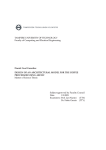


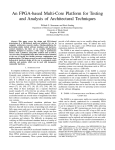


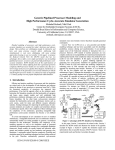
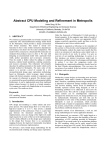

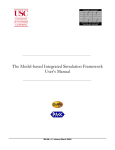
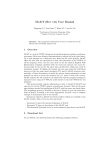
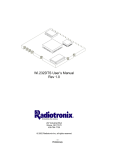
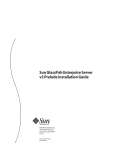
![Delibera n. 0987 del 12 agosto 2014, [file]](http://vs1.manualzilla.com/store/data/006108852_1-32b52cfe2cc0725a2325d47d9b52251a-150x150.png)



